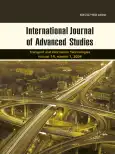Reducing the Congestion at a Bus Stop by Forming Groups of Buses in Chelyabinsk City
- Authors: Averyanov Y.I.1, Asfoor H.M.1
-
Affiliations:
- South Ural State University
- Issue: Vol 14, No 1 (2024)
- Pages: 106-120
- Section: Articles
- Published: 31.03.2024
- URL: https://journal-vniispk.ru/2328-1391/article/view/299558
- DOI: https://doi.org/10.12731/2227-930X-2024-14-1-246
- EDN: https://elibrary.ru/CHXICU
- ID: 299558
Cite item
Full Text
Abstract
The one of the main problems of congestion processes at bus stopping points (SP) is that an increase in the number of buses and routes leads to a disruption in the organization of their passage through the SP. The poor organization of bus passage through the SP can lead to the fact that during peak hours, the buses queue can stretch for hundreds of meters. The forming buses into a group can reduce the congestions at the SP and increase their throughput, as a result of the simultaneous arrival and departure of buses from the SPs. In order to check the stated hypothesis, experimental and theoretical studies were carried out on the process of passing buses through the SP “Revolution Sq." on Lenin Ave., Chelyabinsk city, Russia. In this article was found that, when using three buses in one group, the passenger service time at the SP will be reduced in the range of (52-56) %. This result can lead to assert that the buses movement in a group through the SP will increase its capacity by approximately 50% and reducing the possibility of congestion at bus stopping points.
Purpose. Reducing the congestion at the bus stopping points by forming groups of buses.
Methodology. In the article the observation and comparison methods are used as the analysis methods.
Results. The most informative parameters showing some aspects of carrying out the analysis of export operations are received.
Practical implications. The diagrams of the main data of experimental studies and theoretical dependences of the dwell time that spent by three buses in one group and three buses arriving one by one at SP “Revolution Sq." are got from the route numbers in the morning and evening.
About the authors
Yuri I. Averyanov
South Ural State University
Author for correspondence.
Email: aver541710@mail.ru
ORCID iD: 0000-0002-5934-4436
Scopus Author ID: 57202610487
Professor of the Department of Life safety, Doctor of Technical Sciences
Russian Federation, 76, Lenin Ave., Chelyabinsk, Chelyabinsk Region, 454080, Russian FederationHasanain Muhi Asfoor Asfoor
South Ural State University
Email: iraqieng2003@yahoo.com
ORCID iD: 0000-0003-3448-101X
Scopus Author ID: 57222469510
Department Applicant in the Department of Automobile Transport
Russian Federation, 76, Lenin Ave., Chelyabinsk, Chelyabinsk Region, 454080, Russian FederationReferences
- Averyanov Y.I., Asfoor H.M.A, Golenyaev N.S. Influence of the Speed of Motion of Public Motor Transport and the Time of the Green Signal of the Light Traffic on the Formation of Their Transport Flow. IOP Conference Series: Earth and Environmental Science, 2021, vol. 666, no. 4, p. 042085. https://doi.org/10.1088/1755-1315/666/4/042085
- Freeman J. Technical Memorandum–Transit Signal Priority Implementation on International Drive: TSP Evaluation Summary Draft. Kittelson and Associates. Inc. 2013.
- Fernandez R., Planzer R. On the capacity of bus transit systems. Transport reviews, 2002, vol. 22(3), pp. 267-293. https://doi.org/10.1080/01441640110106328
- Romea G., Estrada M. Analysis of an autonomous driving modular bus system. Transportation Research Procedia, 2021, vol. 58, pp. 181-188. https://doi.org/10.1016/j.trpro.2021.11.025
- Аверьянов Ю.И. Теоретическое обоснование скоростного режима общественного автотранспорта для безостановочного проезда регулируемого перекрестка / Ю. И. Аверьянов, Х. М. А. Асфур, Н. С. Голеняев // Вестник Южно-Уральского государственного университета. Серия: Экономика и менеджмент. 2021. Т. 15, № 1. С. 182-188. https://doi.org/10.14529/em210119 [Averyanov Yu.I., Asfoor H.M.A., Golenyaev N.S. Theoretical Rationale of the Speed Mode of Public Transport for Non-stop Passage at a Signal-Controlled Crossing. Bulletin of the South Ural State University. Ser. Economics and Management, 2021, vol. 15, no. 1, pp. 182-188. https://doi.org/10.14529/em210119]
- Szasz P.Á., de Carvalho Montans L., Ferreira E. O. COMONOR: ordinated bus convoy (No. 9). Companhia de Engenharia de Tráfego. 1978.
- Meirelles A. A review of bus priority systems in Brazil: from bus lanes to busway transit. Smart Urban Transport Conference, 2000, Brisbane, Queensland, Australia, 2000.
- Asfoor H.M.A., Averyanov Y.I. Bus Stop Points for Urban Passenger Transport and the Factors That Influence Their Capacity. 2021 International Conference on Advance of Sustainable Engineering and its Application (ICASEA). IEEE, 2021, pp. 137-140. https://doi.org/10.1109/ICASEA53739.2021.9733084
- Gibson J., Fernández R. Recomendaciones para el diseño de paraderos de buses de alta capacidad. Apuntes de ingeniería, 1995, vol. 18(1), pp. 35-50.
- Jacques K.S., Levinson H.S. Operational analysis of bus lanes on arterials. Report 26. Transportation Research Board, 1997. https://onlinepubs.trb.org/onlinepubs/tcrp/tcrp_rpt_26-a.pdf
- Daganzo C.F. Structure of competitive transit networks. Transportation Research Part B: Methodological, 2010, vol. 44(4), pp. 434-446. https://doi.org/10.1016/j.trb.2009.11.001
- Highway capacity manual. Washington, DC, 2000. https://sjnavarro.wordpress.com/wp-content/uploads/2008/08/highway_capacital_manual.pdf
- Germani E., Szasz P.A. COMONOR-A bus convoy system. 30th IEEE Vehicular Technology Conference, 1980, vol. 30, pp. 413-417. https://doi.org/10.1109/VTC.1980.1622844
- Çalışkanelli S. P., Coşkun Atasever F., Tanyel S. Start-up lost time and its effect on signalized intersections in Turkey. Promet – Traffic&Transportation, 2017, vol. 29, no. 3, pp. 321-329. https://doi.org/10.7307/ptt.v29i3.2214
- Asfoor H.M.A., Averyanov Y.I., Golenyaev N.S. Improving the Bus Stops Capacity Depending on Capacity of Bus Lane and Regulated Intersection Capacity. IOP Conference Series: Earth and Environmental Science, 2023, vol. 1232, no. 1, p. 012050. https://doi.org/10.1088/1755-1315/1232/1/012050
Supplementary files










